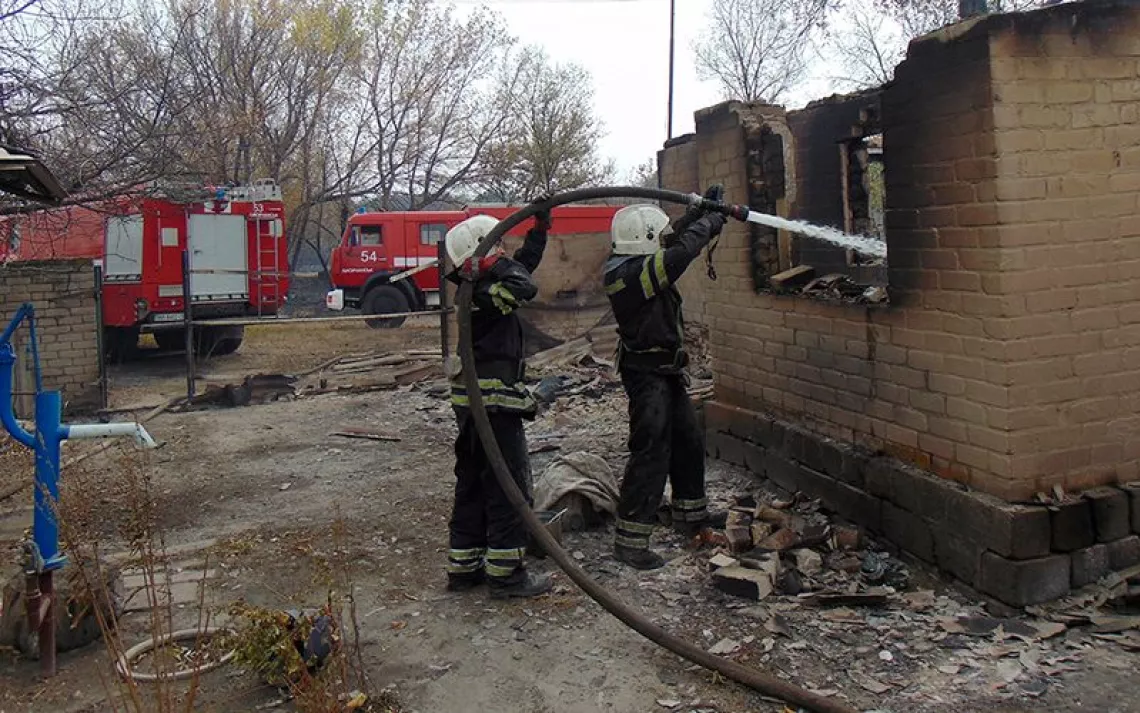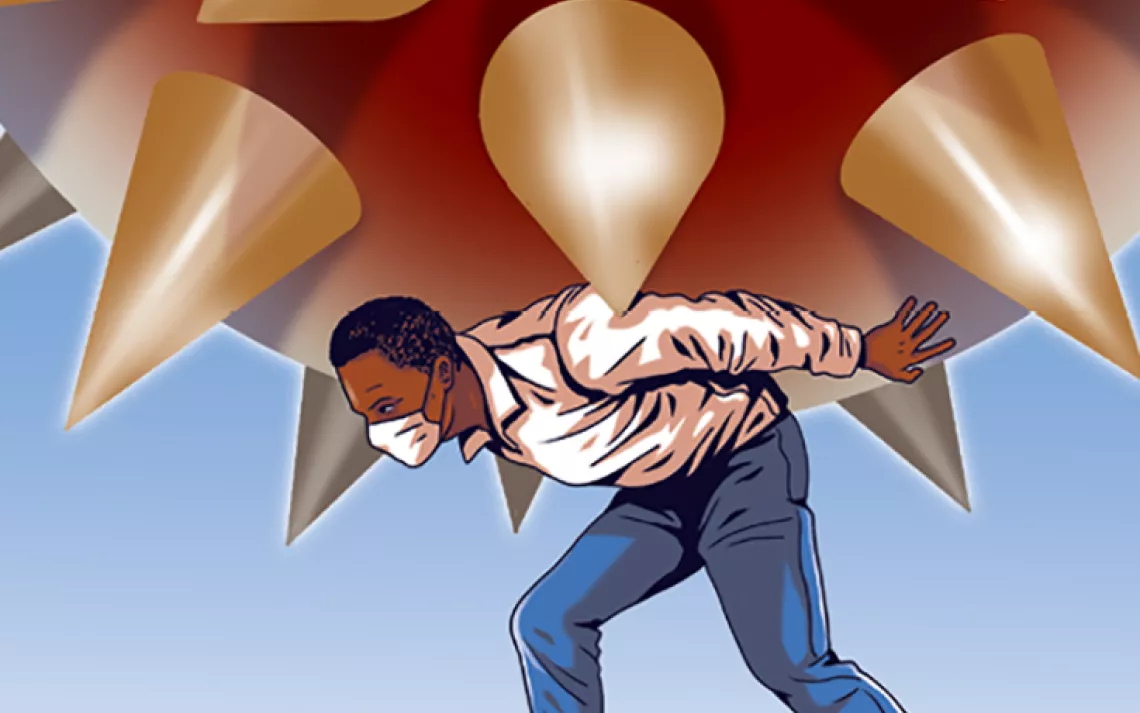6 Survival Skills You Can Practice in Quarantine
Learn your knots and pitch a living room shelter, but be careful with those accelerants!
Photo by Lauren Evans

In the absence of anything else to do, I’ve recently found myself enthralled by the reality show Naked and Afraid, in which a man and a woman are left to survive in some remote wilderness for 21 days with little by way of tools and nothing by way of clothing. I love the show for the same reason I love adventure books featuring protagonists thrown into miserable, life-threatening situations: They make me feel cozy. It’s not that I want anyone to break their leg while falling off the west face of Siula Grande or to have to weigh whether to eat their seatmate after crash landing in the Andes. It’s that stories of extreme outdoor hardship help me to be grateful for where I am: nestled on the couch under a freshly laundered blanket, one hand petting a sleeping cat and the other plunged deep into a family-size bag of cheese curls.
Another thing the show has done is make me acutely aware of just how unprepared I am when I venture alone into the wilderness, naked or not. And it’s not just me—research has shown, for example, that day hikers are far more vulnerable when lost than those on multiday expeditions, because they often lack the necessary gear and knowledge to survive outside for an extended period of time.
There is so much about our current situation that has made me feel helpless, and that feeling has provided a perfect habitat for depression to take root. But a good way to counter that, I've found, is learning how to be self-sufficient. Like many others, I’ve started cooking more, cutting my own hair, fixing things on my bike that I normally would have passed off to a mechanic. It’s empowering to seize control of these little things, to know that each new skill I learn is something that can’t be taken from me, no matter how hamstrung I am in so many other ways.
The weather is getting nicer too, and someday we’ll be able to go outside again. I spoke with four wilderness survival experts about some of the most helpful skills you can learn inside your own four walls. Practice them while you shelter in place, and leave lockdown more independent and capable than you were when you went in.
How to navigate with a compass
Learning to use a compass is perhaps the most useful of backcountry safety skills—because you’ll never have to resort to drastic measures if you don’t get lost in the first place.
It’s also something you can easily learn at home. REI has a good tutorial that concisely explains the parts of your compass and how to use it in conjunction with the topographical map you can download for free from the US Geological Survey’s website. The Appalachian Mountain Club also has a thorough explainer, if you’d prefer to read rather than watch. If you really want to get into the nitty-gritty (and, why not? you’ve got time!) get yourself a copy of Be Expert With Map and Compass by Bjorn Kellstrom.
Bear in mind, though, that you’ll likely encounter interference when using your compass inside, says Dave DiCerbo (who, along with his wife, Jessica Tackett, owns New York’s Destination Backcountry Adventures). Taking walks around your neighborhood can be a great opportunity to practice: Just print out a map on Google and start to figure out how measuring degrees and bearings feels when you’re out on the land.
How to make a tarp shelter
If you do get lost, you’re going to want to be able to make a shelter. According to Eric Kulick, the founder and chief instructor of True North Wilderness Survival School, 95 percent of search-and-rescue cases are resolved within 72 hours. If you can protect yourself from the elements for that long, your chances of being found alive increase exponentially.
“Shelter is more important than fire,” Kulick says. “I mean, fire is great, but who wants to sit out in the pouring rain with a fire? I’d rather be holed up in a shelter.”
In urgent cases (and on Naked and Afraid), people use materials that they find outside, like branches and sticks. But a poncho or a plastic drop cloth—which Kulick recommends bringing on outings of any length, including day hikes—can create a range of shelters that are actually waterproof. While there are a number of configurations you can create, a good place to start is with this video from Tony Nester, a.k.a. the Survival Guru, on how to build one with just a tarp, sticks, and a rope. If you’ve got a tarp already, grab some hiking poles and cord and pitch it in your living room. Voila! A brand-new home office or meditation retreat. Don’t let anyone enter unless they knock.
How to make a splint and other wilderness first aid
As with an emergency shelter, you hope you’ll never have to use even basic first aid while out on the trail. But if you do find yourself miles from civilization with a broken ankle, you’ll be supremely grateful you took this forced downtime to get comfortable learning how to make a splint.
Rigid gear like hiking poles and tent poles (or any similar items you might find in your basement) can be repurposed for immobilizing a broken bone. Soft items like a puffy jacket can be used as padding, and a bandana or tent guylines can tie it all together. Practice this technique on yourself, or on your significant other while they’re trying to work. (They’ll thank you later, probably!)
And since you’ve already roped your quarantine mates into your training, you can also practice conducting patient assessments. With these, “you go head to toe down a patient and uncover any truly serious or life-threatening injuries,” says Thomas Coyne, who runs California’s Thomas Coyne Survival Schools. While a seasoned EMT or wilderness first aid provider can run through the whole assessment in around 30 seconds, it can take a novice several minutes to get it right.
Once you do, you’ll be in much better shape for any accidents that happen in the future, be it helping someone who tumbled off a rock while climbing or just went over their handlebars on a bike. “You’re going to be ready to check them out and see if there’s anything life-threatening and be able to stabilize it right away,” Coyne says, “instead of wondering what the hell’s going on.”

Make every day an Earth Day
Get articles like this one sent directly to your inbox.
With this action you affirm you want to receive Sierra Club communications and may vote on policy designated by the Sierra Club Board.
Learn essential knots
There is no limit to the number of knots you could learn, but luckily you can accomplish most outdoor tasks with only a few. Moreover, learning to tie knots is a good, tactile activity, and in times like these, says DiCerbo, “it’s a really wonderful thing right now to kill some stress.”
The great thing about knots is that you don’t have to wait until quarantine is over to concoct practical ways to use them. Practice a square knot by making an extra long dog leash for your pooch. Use a clove hitch to tie that same pooch (or another, I don’t care) to a signpost while you grab your takeout order. Practice your trucker’s hitch by tying out the guylines of the tent you pitched especially for your pooch in the backyard. The double fisherman’s knot can be used to tie your pooch to another pooch, provided they both have the leashes.
Make a knot, and make it again. If you find your pooch has gone missing, it’s either because A) your tied your knots wrong and you should keep practicing, or B) it got tired of watching you practice tying knots and left to find another family with better dinner options. Don’t take it personally.
Make some accelerants
The whole point of quarantine is to not do anything stupid that might further tax the already-stretched emergency response system, which means you should probably rule out starting fires around your house for practice. That said, if you’re looking for a hands-on activity that will save your future self some time (and doesn’t involve sourdough starter), consider stirring up a batch homemade accelerants for a quick start to your next campfire.
While you can use a variety of household items like cotton balls and petroleum jelly, DiCerbo’s favorite is what he calls a “fire cake.” First, collect about a cup of laundry lint (cotton only!) from the trap in a clothes dryer. Next, melt some paraffin in a fireproof container and push the lint in. Once the container is full, put it in the freezer until needed. The resulting “cake” will be about the size of a hockey puck and can be cut into 12 pieces, each of which will burn for around five minutes.
“It’s awesome if you’re dealing with any kind of wet conditions, DiCerbo says. “It’s not volatile and doesn’t need to be stored in a plastic bag like Vaseline balls, which burn up pretty quickly. This is a nice, low, slow burn.”
Have a positive mental attitude
Quarantine is also a great time to practice one of the most valuable skills in wilderness survival: having a positive mental attitude or PMA. That might sound hokey, but the benefits of PMA are actually physiological. Keeping your spirits high and staving off panic lowers your stress levels and frees up mental space to allow you to think more clearly and make better decisions.
Living in quarantine is in itself a survival situation—and approaching it as such can be extremely beneficial. Laurence Gonzales’s Deep Survival is a classic when it comes to understanding why certain people are able to make it out of seemingly hopeless situations and how to train your own mind to adopt a survivors’ mentality. Other reads, like Into Thin Air, Touching the Void, and Jungle can not only help you appreciate the beauty of being indoors but also be instructive when you’re not. As Kulick says, “It just makes your situation so much better when you know how hard someone else had it.”
 The Magazine of The Sierra Club
The Magazine of The Sierra Club



